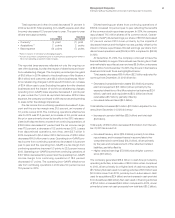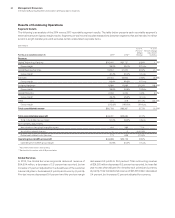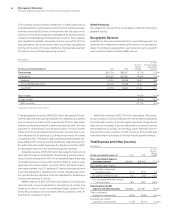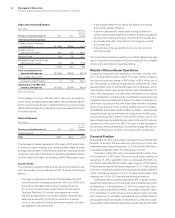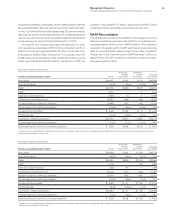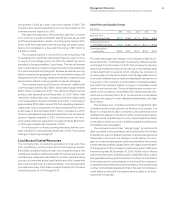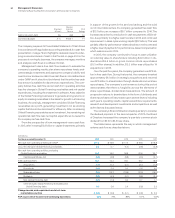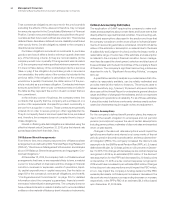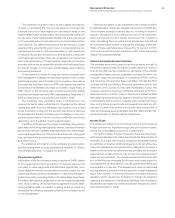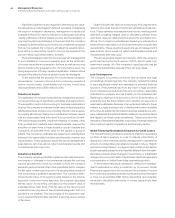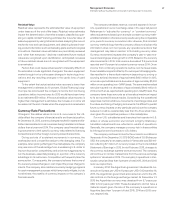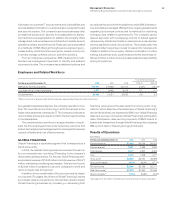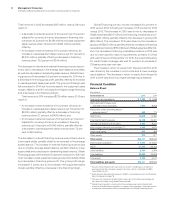IBM 2015 Annual Report Download - page 63
Download and view the complete annual report
Please find page 63 of the 2015 IBM annual report below. You can navigate through the pages in the report by either clicking on the pages listed below, or by using the keyword search tool below to find specific information within the annual report.
61
Management Discussion
International Business Machines Corporation and Subsidiary Companies
first quarter of 2016 as it was in the fourth quarter of 2015. The
company also expects acquisitions to drive improvement in the
software revenue trajectory in 2016.
Free cash flow realization, defined as free cash flow to income
from continuing operations (GAAP), was 98percent as reported
in 2015 and is expected to remain in the 90’s percent level in 2016.
At the profit level associated with the earnings per share expec-
tations, this translates to a free cash flow range of $11billion to
$12billion in 2016.
The company expects, in the normal course of business, that
its operating (non-GAAP) tax rate will be 18percent, plus or minus
a couple of percentage points, for 2016. The GAAP tax rate is
expected to be approximately 1 point lower. The rate will change
year to year based on nonrecurring events, such as the settlement
of income tax audits and changes in tax laws, as well as recurring
factors including the geographic mix of income before taxes, the
timing and amount of foreign dividend repatriation, state and local
taxes and the effects of various global income tax strategies.
The company expects 2016 pre-tax retirement-related plan
cost to be approximately $2.0billion, a decrease of approximately
$600million compared to 2015. This estimate reflects current
pension plan assumptions at December31, 2015. Within total
retirement-related plan cost, operating retirement-related plan
cost is expected to be approximately $1.4billion, a decrease of
approximately $100million versus 2015. Non-operating retirement-
related plan cost is expected to be approximately $500million,
a decrease of approximately $500million compared to 2015,
driven by decreased recognized actuarial losses and the Spanish
pension litigation impacts in 2015. Contributions for all retire-
ment-related plans are expected to be approximately $2.6billion
in 2016, approximately flat compared to 2015.
For a discussion of new accounting standards that the com-
pany will adopt in future periods, please see noteB, “Accounting
Changes,” beginning on page92.
Liquidity and Capital Resources
The company has consistently generated strong cash flow
from operations, providing a source of funds ranging between
$16.9billion and $19.8billion per year over the past five years. The
company provides for additional liquidity through several sources:
maintaining an adequate cash balance, access to global funding
sources, a committed global credit facility and other committed
and uncommitted lines of credit worldwide. The following table
provides a summary of the major sources of liquidity for the years
ended December31, 2011 through 2015.
Cash Flow and Liquidity Trends
($ inbillions)
2015 2014 2013 2012 2011
Net cash from
operating activities $17.0 $16.9 $17.5 $19.6 $19.8
Cash and short-term
marketable securities $ 8.2 $ 8.5 $11.1 $11.1 $11.9
Committed global
credit facility $10.0 $10.0 $10.0 $10.0 $10.0
The major rating agencies’ ratings on the company’s debt securi-
ties at December31, 2015 appear in the following table and remain
unchanged from December31, 2014. The company’s indenture
governing its debt securities and its various credit facilities each
contain significant covenants which obligate the company to
promptly pay principal and interest, limit the aggregate amount
of secured indebtedness and sale and leaseback transactions to
10percent of the company’s consolidated net tangible assets,
and restrict the company’s ability to merge or consolidate unless
certain conditions are met. The credit facilities also include a cov-
enant on the company’s consolidated net interest expense ratio,
which cannot be less than 2.20 to 1.0, as well as a cross default
provision with respect to other defaulted indebtedness of at least
$500million.
The company is in compliance with all of its significant debt
covenants and provides periodic certification to its lenders. The
failure to comply with its debt covenants could constitute an event
of default with respect to the debt to which such provisions apply.
If certain events of default were to occur, the principal and interest
on the debt to which such event of default applied would become
immediately due and payable.
The company does not have “ratings trigger” provisions in its
debt covenants or documentation, which would allow the holders
to declare an event of default and seek to accelerate payments
thereunder in the event of a change in credit rating. The com-
pany’s contractual agreements governing derivative instruments
contain standard market clauses which can trigger the termination
of the agreement if the company’s credit rating were to fall below
investment grade. At December31, 2015, the fair value of those
instruments that were in a liability position was $186million, before
any applicable netting, and this position is subject to fluctuations
in fair value period to period based on the level of the company’s
outstanding instruments and market conditions. The company has
no other contractual arrangements that, in the event of a change in
credit rating, would result in a material adverse effect on its finan-
cial position or liquidity.


